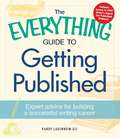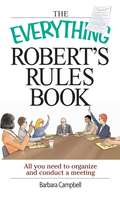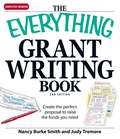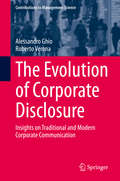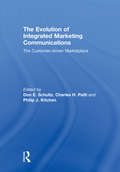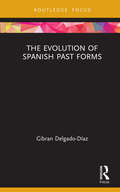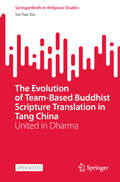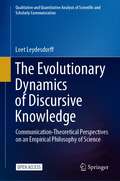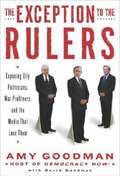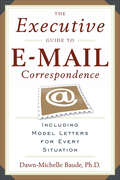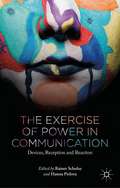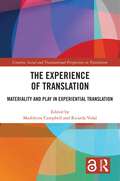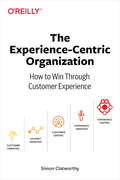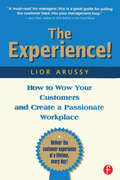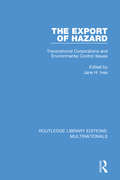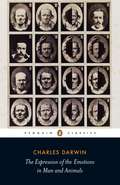- Table View
- List View
The Everything Guide to Being an Event Planner: Insider Advice on Turning Your Creative Energy into a Rewarding Career
by Jennifer MancusoDo you love throwing parties? Are you the most organized person you know? Can you thrive in a fast-paced environment? If so, event planning could be your perfect career choice! Seasoned event planner Jennifer Mancuso helps you to get started and succeed in this exciting field.This book's insider tips and step-by-step guidance will teach you how to:Tailor events to each client - from a corporate dinner to an intimate weddingMarket and network to keep business comingHire vendors that your client will loveBuild a great reputation in your area and beyondWhether you've recently earned a hospitality degree or are simply looking for a fun career change, The Everything Guide to Being an Event Planner will help you break out of the routine and start a new, creative endeavor-one celebration at a time!
The Everything Guide to Getting Published
by Randy Ladenheim-GilYou've always wanted to be an author. And now you're ready to get started. But getting that manuscript written and published is not so easy. In this guide, you'll find the expert advice of industry insiders--editors, agents, and successful authors. You'll learn tips and tricks about submissions, how to write a killer query, and even how to navigate the uncertain waters of self-publishing and e-books. Whether you're a beginner or an experienced writer, here is everything you need to take an idea to the printed page, including: Guidance on planning a writing career and building a platform Surefire ways to get a submission taken seriously Contract negotiation tips from the pros An in-depth exploration of self-publishing and e-books This essential guide also includes an exclusive link to a FREE get-published webinar, sponsored by the prestigious writing magazine Writer's Digest. This multimedia package is loaded with insider tips and professional techniques--all you need to turn writing from a hobby into a profession!
The Everything Guide to Getting Published
by Randy Landenheim-GilYou've always wanted to be an author. And now you're ready to get started. But getting that manuscript written and published is not so easy. In this guide, you'll find the expert advice of industry insiders--editors, agents, and successful authors. You'll learn tips and tricks about submissions, how to write a killer query, and even how to navigate the uncertain waters of self-publishing and e-books. Whether you're a beginner or an experienced writer, here is everything you need to take an idea to the printed page, including: Guidance on planning a writing career and building a platform Surefire ways to get a submission taken seriously Contract negotiation tips from the pros An in-depth exploration of self-publishing and e-books This essential guide also includes an exclusive link to a FREE get-published webinar, sponsored by the prestigious writing magazine Writer's Digest. This multimedia package is loaded with insider tips and professional techniques--all you need to turn writing from a hobby into a profession!
The Everything Guide to Getting Published: Expert advice for building a successful writing career
by Randy Landenheim-GilYou've always wanted to be an author. And now you're ready to get started. But getting that manuscript written and published is not so easy. In this guide, you'll find the expert advice of industry insiders--editors, agents, and successful authors. You'll learn tips and tricks about submissions, how to write a killer query, and even how to navigate the uncertain waters of self-publishing and e-books. Whether you're a beginner or an experienced writer, here is everything you need to take an idea to the printed page, including:Guidance on planning a writing career and building a platformSurefire ways to get a submission taken seriouslyContract negotiation tips from the prosAn in-depth exploration of self-publishing and e-books This essential guide also includes an exclusive link to a FREE get-published webinar, sponsored by the prestigious writing magazine Writer's Digest. This multimedia package is loaded with insider tips and professional techniques--all you need to turn writing from a hobby into a profession!
The Everything Negotiating Book
by Margaret Kaeter Angelique PinetWhat's the one thing you can do to improve both your business and personal life? Learn to negotiate. Negotiating effectively is the key to getting what you want when you want it. Negotiate well, and you maintain control in any situation, at home or at work. From purchasing a home and asking for a raise to compromising with spouses and children, The Everything Negotiating Book takes you step by step through the negotiating process, enabling you to: Communicate your goals clearly and concisely State your case effectively Identify body language to read hidden clues Compromise without giving in Anticipate reactions and plan your responses Maintain your composure and professionalism Gain the advantage Debate terms and conditions favorably Decide when to walk away-and when to persist And much, much more! Whether you're planning a hostile takeover or debating with your spouse, The Everything Negotiating Book prepares you for the battle, and arms you with the skills you need to win.
The Everything Negotiating Book: Savvy Techniques For Getting What You Want --at Work And At Home
by Margaret KaeterWhat's the one thing you can do to improve both your business and personal life? Learn to negotiate. Negotiating effectively is the key to getting what you want when you want it. Negotiate well, and you maintain control in any situation, at home or at work. From purchasing a home and asking for a raise to compromising with spouses and children, The Everything Negotiating Book takes you step by step through the negotiating process, enabling you to:Communicate your goals clearly and conciselyState your case effectivelyIdentify body language to read hidden cluesCompromise without giving inAnticipate reactions and plan your responsesMaintain your composure and professionalismGain the advantageDebate terms and conditions favorablyDecide when to walk away-and when to persistAnd much, much more!Whether you're planning a hostile takeover or debating with your spouse, The Everything Negotiating Book prepares you for the battle, and arms you with the skills you need to win.
The Everything Robert's Rules Book: All you need to organize and conduct a meeting (Everything® Series)
by Barbara CampbellGet your meeting attendees to play by the rules!Have you ever been to a meeting that dissolved into utter chaos? Or attended a meeting that seemed unfocused and unproductive?Robert's Rules of Order have been the standard of parliamentary procedure for business and civic organizations since 1876. The Everything Robert's Rules Book fully explains Robert's Rules and shows you how to apply them to today's social and business meeting situations.Features clear explanation of:Types of meetings and their rulesProper voting proceduresThe rules of debateWhen and how to use motionsProper minute-takingStandards for teleconferencing and e-mailingThe Everything Robert's Rules Book is your one-stop reference to holding productive, successful meetings.
The Everything® Grant Writing Book
by Judy Tremore Nancy Burke SmithHave you ever dreamed about making money as a freelance grant writer? Or are you applying for a grant and anticipate fierce competition? The Everything. Grant Writing Book helps you confront this competitive market with detailed, insider information on getting through the gatekeepers to obtain the funds you need. This detailed book, written by experienced grant writer Nancy Burke Smith and freelance writer Judy Tremore, shows you exactly how create the perfect grant proposal -- no matter how daunting the specifications are for the project. The Everything. Grant Writing Book shows you how to: 7Apply for government and foundation grants7Find the money needed7Build community collaborations and partnerships7Write a statement of need7Develop a budget and budget narrative7Fill out appropriate paperworkFrom writing a letter of inquiry or intent to developing action plans and timelines to outlining and drafting the proposal, The Everything. Grant Writing Book helps you get the funds you need!
The Everything® Guide To Being An Event Planner
by Jennifer MancusoWhether you've recently earned a hospitality degree or are simply looking for a fun career change, The Everything Guide to Being an Event Planner will help you break out of the routine and start a new, creative endeavor-one celebration at a time!
The Everything® Negotiating Book
by Angelique PinetWhat's the one thing you can do to improve both your business and personal life? Learn to negotiate. Negotiating effectively is the key to getting what you want when you want it. Negotiate well, and you maintain control in any situation, at home or at work. From purchasing a home and asking for a raise to compromising with spouses and children, The Everything Negotiating Book takes you step by step through the negotiating process, enabling you to: Communicate your goals clearly and concisely State your case effectively Identify body language to read hidden clues Compromise without giving in Anticipate reactions and plan your responses Maintain your composure and professionalism Gain the advantage Debate terms and conditions favorably Decide when to walk away-and when to persist And much, much more! Whether you're planning a hostile takeover or debating with your spouse, The Everything Negotiating Book prepares you for the battle, and arms you with the skills you need to win.
The Evolution of Corporate Disclosure: Insights on Traditional and Modern Corporate Communication (Contributions to Management Science)
by Alessandro Ghio Roberto VeronaThis book provides a critical analysis of the evolution of corporate disclosure. Building upon prior academic literature, it assesses the most important changes in mandatory corporate disclosure, the growing relevance of social and environmental disclosure, and revolutionary new forms of corporate communication, in particular social media. It also includes empirical analyses that shed further light on the impact of voluntary communication, i.e. social and environmental reporting and corporate social media communication, on managerial and investment decisions. Lastly, it discusses new directions for accounting and corporate governance research on the theoretical and empirical challenges of corporate disclosure. Offering a wealth of relevant and timely advice, the book will help regulators design policies that allow businesses to overcome current and emerging economic, social, and technological challenges.
The Evolution of Integrated Marketing Communications: The Customer-driven Marketplace
by Philip J. Kitchen Don E. Schultz Charles H. PattiThis book reviews, updates and enhances the basic concepts surrounding the academic theory and practice of Integrated Marketing Communication (IMC). Since the introduction of IMC in the late 1980s, the concept has spread around the world. In that expansion, many authors have written about IMC; practitioners have adopted and adapted the concept to fit their own market situations. Further, dramatic changes have occurred in the technologies used in marketing communications which consumers have accepted and employed in their consumption of marketers' messages and incentives. Thus, there have been dramatic changes in how IMC was initially envisioned and how it has developed over time. This book identifies and discusses these changes, how they have occurred and what they mean going forward for all types of marketers around the world. Thus, IMC, and indeed integration of communications at all organisational levels is an essential in the 21st century organisations. This book was published as a special issue of the Journal of Marketing Communications.
The Evolution of Mathematics: A Rhetorical Approach (RSA Series in Transdisciplinary Rhetoric)
by G. Mitchell ReyesThere is a growing awareness among researchers in the humanities and social sciences of the rhetorical force of mathematical discourse—whether in regard to gerrymandering, facial recognition technologies, or racial biases in algorithmic automation. This book proposes a novel way to engage with and understand mathematics via a theoretical framework that highlights how math transforms the social-material world.In this study, G. Mitchell Reyes applies contemporary rhetorical analysis to mathematical discourse, calling into question the commonly held view that math equals truth. Examining mathematics in historical context, Reyes traces its development from Plato’s teaching about abstract numbers to Euclidian geometry and the emergence of calculus and infinitesimals, imaginary numbers, and algorithms. This history reveals that mathematical innovation has always relied on rhetorical practices of making meaning, such as analogy, metaphor, and invention. Far from expressing truth hidden deep in reality, mathematics is dynamic and evolving, shaping reality and our experience of it.By bringing mathematics back down to the material-social world, Reyes makes it possible for scholars of the rhetoric and sociology of science, technology, and math to collaborate with mathematicians themselves in order to better understand our material world and public culture.
The Evolution of Spanish Past Forms (Routledge Studies in Hispanic and Lusophone Linguistics)
by Gibran Delgado-DíazThe Evolution of Spanish Past Forms examines how Spanish past forms have changed diachronically. With examples from Medieval Spanish, Golden Age Spanish, and Modern Spanish literary works, this book demonstrates how language is dynamic and susceptible to change. The past forms considered here include the preterit, the imperfect, the imperfect progressive with estar (temporal to be), the present perfect, the imperfect progressive with other auxiliary verbs, the preterit progressive with estar, and the preterit progressive with other auxiliary verbs. This book will be of interest to scholars and graduate students investigating tense and aspect phenomena in Spanish and other languages, grammaticalization processes, and language variation and change.
The Evolution of Team-Based Buddhist Scripture Translation in Tang China: United in Dharma (SpringerBriefs in Religious Studies)
by Sai Yau SiuOpen Access This open-access book provides a concise analysis of the apex of team-based translation of Buddhist scriptures during the Tang Dynasty, initiated by the notable gathering of translation experts led by Prabhākaramitra. Showcasing the diverse and innovative strategies of translators who joined forces to surmount barriers, this work highlights how their collaborative translation efforts facilitated the spread of Buddhist teachings throughout China. This book brings to light the often overlooked yet crucial roles of these translation teams and examines their organizational structures, translation processes, and the distinct roles of individual members, offering critical insights into the cultural and religious fabric of the period. By enhancing our understanding of the complex dynamics within these institutions, this work also addresses a significant gap in the historical study of sūtra translation in medieval China. It is an essential resource for scholars, students, and enthusiasts of Buddhism, translation studies, and Chinese history.
The Evolutionary Dynamics of Discursive Knowledge: Communication-Theoretical Perspectives on an Empirical Philosophy of Science (Qualitative and Quantitative Analysis of Scientific and Scholarly Communication)
by Loet LeydesdorffThis open access book addresses three themes which have been central to Leydesdorff's research: (1) the dynamics of science, technology, and innovation; (2) the scientometric operationalization of these concept; and (3) the elaboration in terms of a Triple Helix of university-industry-government relations. In this study, I discuss the relations among these themes. Using Luhmann's social-systems theory for modelling meaning processing and Shannon's theory for information processing, I show that synergy can add new options to an innovation system as redundancy. The capacity to develop new options is more important for innovation than past performance. Entertaining a model of possible future states makes a knowledge-based system increasingly anticipatory. The trade-off between the incursion of future states on the historical developments can be measured using the Triple-Helix synergy indicator. This is shown, for example, for the Italian national and regional systems of innovation.
The Exception to the Rulers: Exposing Oily Politicians, War Profiteers, and the Media that Love Them
by Amy Goodman David GoodmanHost of Pacifica Radio's Democracy Now! Analyzes world events.
The Executive Guide to E-mail Correspondence: Including Model Letters for Every Situation
by Dawn-Michelle BaudeMake your messages shorter, simpler, and more effective with this guide to writing e-mails that get read—and get results.As we correspond with everyone from international partners to remote workers, writing skills are more important than ever to business and career success. They can make the difference between climbing the corporate ladder and getting stuck on a low rung. An e-mail that’s clear, concise, and targeted will get more than just a response. It will get results—including your boss’s attention.No matter what sector a company is in, excellent written communication skills are in demand—because too-long, wordy, or unclear emails bog down a business. This guide provides insight, guidelines, and a wide variety of templates to help you get it right and rapidly transform basic writing skills into global communications expertise. In a lively, here’s-how style, it:demonstrates the hallmarks of effective business e-mailsfeatures ready-to-use organizational planspresents quick and easy editing techniquesfurnishes before-and-after editing modelsfocuses on the do’s and don’ts of proficient e-mailssupplies practical writing tips and tricks, and more
The Exercise of Power in Communication
by Rainer Schulze Hanna PishwaPower Exercise explores the various choices speakers or communicators make when expressing power relations in modern societies. The volume brings together several disciplines, such as linguistics, sociology, communication studies and social psychology, to give insight into how interactants co-construct different aspects of power in their everyday life. The chapters reveal that the power potential of linguistic elements is dependent on context and is by no means fixed or predetermined, whichprovides implications for research methodology.
The Experience of Translation: Materiality and Play in Experiential Translation (Creative, Social and Transnational Perspectives on Translation)
by Madeleine CampbellCampbell, Vidal and their contributors expand the notion of translation beyond linguistic, modal and medial borders to embrace posthumanist perspectives through a holistic experiential epistemology which envisions translation as engaged, situated social practice.The first of two volumes, this book focuses on questions of materiality and play. Drawing together contributions on theory, methodology and practice from translators, scholars and practitioners working in the creative and performing arts, this book explores how contemporary, experiential acts of interpretation, mediation and negotiation can serve to bridge social and cultural discontinuities across time and space. These range from ancestral past to digital present, from rural to urban environments across the globe. Experiential translation applies a transdisciplinary lens to problematize views of translation and untranslatability traditionally bound by structuralist frames of reference and the reserve of professional linguistic translation. The chapters in this book apply this experiential lens to understand a pluriverse of creative translation practices where the translator’s subject position in relation to the ‘original’ is transformed by the role of experimentation, creativity and play. This book and its companion volume The Translation of Experience: Cultural Artefacts in Experiential Translation will be of particular interest to translators and arts practitioners, scholars and researchers in the transdisciplinary field of humanities.Funding: This work was supported by UKRI under AHRC Grant AH/V008234/1, awarded to Ricarda Vidal, King’s College London (Principal Investigator) and Madeleine Campbell, University of Edinburgh (Co-Investigator).
The Experience-Centric Organization: How to Win Through Customer Experience
by Simon David ClatworthyIs your organization prepared for the next paradigm of customer experience, or will you be left behind? This practical book will make you a winner in a market driven by experience, enabling you to develop desirable offerings and standout service to attract loyal customers.Author Simon Clatworthy shows you how to transform your organization into one that aligns your customers’ experiential journey with platforms, organizational structures, and strategic alliances. Rather than treat customer experience as an add-on to product and service design, you’ll discover how experience-centricity can drive the whole organization.Learn the five steps necessary to transform into an experience-centric organizationExplore the underlying structure needed to design and deliver memorable experiencesUnderstand how customers and clients experience products and servicesDevelop experiential DNA as an extension of your brand DNABe proactive by translating cultural trends into experiences
The Experience: How to Wow Your Customers and Create a Passionate Workplace
by Lior ArussyA 'must-read' for managers; this is a great guide for pulling the customer back into your management loop.' — Jerry Vass, author of Soft Selling in the Hard World 'Lior Arussy spins a cautionary tale for the transition companies m
The Export of Hazard: Transnational Corporations and Environmental Control Issues (Routledge Library Editions: Multinationals)
by Jane H. IvesThis report, first published in 1985, written by a distinguished group of legal and public policy experts, documents the growing trade in hazardous industries and toxic products. Hazard export threatens the health and environment of workers and ordinary citizens the world over. It is carried out by transnational corporations, in order to locate their most dangerous industrial activities outside the US, in countries where regulatory controls may be less strict. The issues represented here include occupational safety, environmental protection, international relations and problems of legal control. Attention is focused on the political and economic impact of hazard export on the US, Europe and developing countries, and the book’s critical analysis is addressed directly to the institutional level best suited to constructive action. This title will be of interest to students of business studies.
The Expression of the Emotions in Man and Animals: The Expression Of The Emotions In Man And Animals (Cambridge Library Collection - Darwin, Evolution And Genetics Ser.)
by Charles DarwinPublished in 1872, The Expression of the Emotions in Man and Animals was a book at the very heart of Darwin's research interests - a central pillar of his 'human' series. This book engaged some of the hardest questions in the evolution debate, and it showed the ever-cautious Darwin at his boldest. If Darwin had one goal with Expression, it was to demonstrate the power of his theories for explaining the origin of our most cherished human qualities: morality and intellect. As Darwin explained, "He who admits, on general grounds, that the structure and habits of all animals have been gradually evolved, will look at the whole subject of Expression in a new and interesting light."

